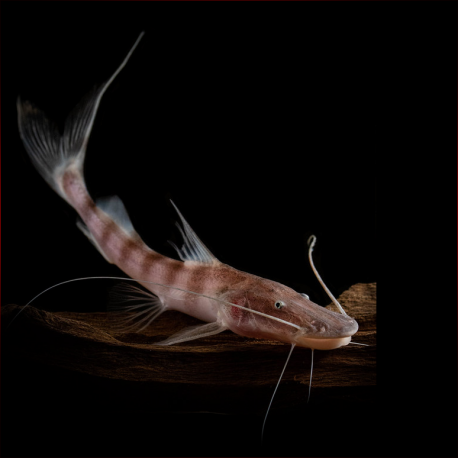More info
Datasheet
| Minimum Tank Size | 30000 litres / 7925.16 US gallons |
| Maximum Size | 50.0cm / 19.69inches |
| Temperature | 22°C / 71.60°F - 32°C / 89.60°F |
| Hardness | 1.01dgH / 18ppm - 12.05dgH / 215ppm |
| pH | 6.0-7.6 |
General DescriptionThe Zebra Shovelnose, scientifically known as Brachyplatystoma Tigrinum, is easily distinguishable by its slender body shape, distinctive color patterns, and extended barbels. Belonging to the Pimelodidae family under the order Siluriformes, this species is unique due to its specific skull morphology and the presence of elongated filaments on the caudal fin lobes.
Aquarium SetupFor optimal care, a tank size of at least 30,000 liters is recommended. The Zebra Shovelnose thrives in water conditions with a hardness of 18-215 ppm, a pH range of 6.0-7.6, and a temperature between 22-32°C. The habitat should mimic its natural environment with a sandy substrate, driftwood pieces, and a robust filtration system. Regular water changes of 50-70% tank volume, along with well-oxygenated water and sufficient water movement, are essential for maintaining this species in captivity.
BehaviourThese catfish species should only be housed with larger tank mates that can't be viewed as potential prey and require similar water parameters. Generally, they exhibit calm behavior in well-maintained aquarium setups but may display territorial tendencies as they grow older.
Feeding and DietThe Zebra Shovelnose is predominantly piscivorous, preying on smaller fish in the wild. In captivity, they readily accept dead alternatives such as shrimp, mussels, and squid. Adults typically require feeding once a week to maintain optimal health.
Reproduction & DimorphismReproduction of the Zebra Shovelnose has not been documented in captivity. In nature, spawning occurs at the end of the dry season with early growth stages observed between June and November. Sexual dimorphism in this species remains unknown.
Habitat and DistributionThese catfish are primarily found in the upper Amazon basin, with the type locality being the falls of Cachoeira do Teotônio in northwestern Brazil. They can also be observed in river basins in Colombia and Peru, with specimens for the aquarium trade frequently sourced from the Loreto Region in Peru. Their natural habitat includes main river channels with white-colored water, high dissolved solids, and strong water flow, with adults often associated with cataracts and rapids. Juveniles are commonly collected from tributary drainages and cultivated to a larger size for the ornamental fish trade.

